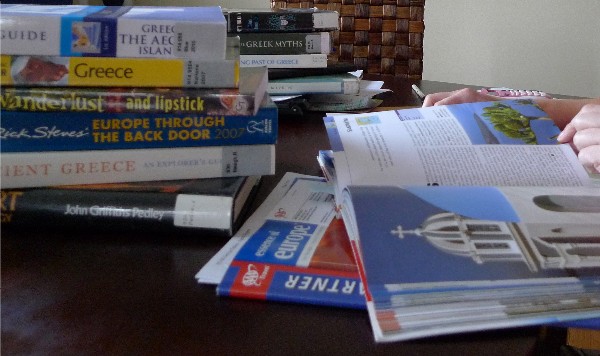Art & Culture, Travel and Excursions
Some Greek reading
While I am exploring the isles, here is my roundup of readings thus far. There will be more to add over time I’m sure.
Greek Islands-Insight Guides, First Edition 1990, Fourth Edition 2010
This book begins with a spread of the main attractions and another spread of Editor’s Choice. The guide has an introduction of culture, an easy-to-read chronology, historic overview (10 pages with pictures) and 6 pages on the islands today. Topics covered include people, religion, architecture, food, cruising, sailing, outdoor pursuits, wildlife, flora, and an out of season page. Places (beginning on page 107) are supplemented with lots of color spreads of photos and include: Athens; Ionian Islands: Corfu, Paxi, Levkada, Ithaki, Kefalonia, Zakynthos, Kythira; Islands of the Saronic Gulf: Salamina, Aegina, Poros, Hydra, Spetses; Cyclades Islands: Andros, Kea, Tinos, Kythnos, Syros, Mykonos, Serifos, Sifnos, Andiparos, Paros, Naxos, Milos, Kimolos, Folegandros, Sikinos, Ios, Amorgos, Dantorini, Anafi; The Sporades and Evvia: Skiathos, Skopels, Alonnisos, Skyros, Evvia; Northeast Aegean: Thasos, Samothraki, Limnos, Agios Efstratios, Lexvos, Psara, Hios, Ikaria, Samos; Dodecanese: Rhodes, Karpathos Kasos, Halki, Kastellorizo, Tilos, Symi, Nisyros, Kos, Pserimos, Astypalea, Kalymnos, Telendos, Leros, Lipsi, Patmos, Arki, Agathonisi; Crete. Then a section on travel tips including transport, accomodation, eating out, activities, language primers, further reading.
Ancient Greece, an explorer’s guide-Interlink Travel by Robert Emmet Meagher and Elizabeth Parker Neave, copyright 2008
For the adventurer who loves to navigate strange roads, this is the guide to read. The book starts with an overview on planning the trip, then covers the history of ancient greece in 29 pages. 3 pages on architecture, 6 pages on gods and legends, a 3-page primer on sacred sites, 4 pages about food, 9 pages on additional travel tips and cultural interactions. The guide then provides 4 itineraries: I covers Minoan Crete over a ten-day period; II focuses on Mycenean civilization in the Peloponnese over ten days; III focuses on Classical civilization in Athens and Attica over six days with a two-page spread of Athenian civics terms; IV covers Aegean Civilization on the Cyclades over seven days. A list of sources/further reading and an index is provided in the back. What I like about this guide is that it provides a traveler with good itineraries to mix and match, gives driving tips for those more adventurous than me, and offers in-depth histories of each site along with a color map illustration. It also has beautiful photos throughout. Although it is more “scholarly” than other guides, the book is easy to read.
Blue Guide: Greece-The Aegean Islands by Nigel McGilchrist, copyright 2010
Various of my other readings recommend the Blue Guide as a go-to-source about Greece. My caveat is that this guide is directed toward true readers. This guide is very text heavy, with the only illustrations showing island maps or site maps. It is also the thickest and therefore heaviest of the guides. However, for the self-guided traveler, this guide offers the most detailed descriptions of sites, blending suggested starting points with historical detail. For Greece in particular the Blue Guides cover various regions with individual guides-from one overall Greece guide to the individual island groupings, so rather than providing a TOC, I recommend you peruse the options available to you and select the one that covers your destinations. This Aegean Guide does not cover Crete nor Athens, but includes my other destinations.
National Geographic Traveler: Greece, Second Edition, copyright 2007
Introductory sections include: Greece today, food and drink, history of Greece (up to 2004), the arts. The ‘Places’ include: Athens/around Athens; Peleponnese (the “hand” of Greece); Central Greece, Thesaly, Epiros; Macedonia and Thrace; Evia; the Aegean Islands including the Sporades, Cyclades and Dodecanese; Corfu and the Ionian Islands. In addition to beautiful photos National Geographic is famous for, the place descriptions have great mini-maps, interesting sidebars and lovely illustrations of those sites would have looked. It even provides a strategy for the larger museums if you only have an hour or two to spare. It has various day-trip suggestions (drives). The back includes recommendations on where to stay, eat and a language guide.
The Living Past of Greece by A.R. And Mary Burn, copyright 1993
This book is packed with archeological detail about the famous sites in Greece and has been referenced as further reading in the more recent guidebooks. Organized in chronological order, it shows the difficulty of the excavation process and the mystery behind uncovering the uses and layouts of buildings. While much more information has been uncovered since 1993, this book is really comprehensive and a great reference for the historical geek (like me). It is a slow read because it is so packed with information, but well-written and laid out. Black and white photos with a lot of floor plans of sites. As an overall guide to Greece this book covers most of the major attractions, but I recommend supplementing it with more detailed guides on the islands you wish to visit.
Greek Art and Archeology by John Griffiths Pedley, copyright 1993
This big book provides a wonderful introduction to ancient Greek art with a comprehensive history of Greece (3000 until 31 B.C.) and photos of how the Greek style evolved. It covers all aspects of art: architecture, pottery, painting, mosaics etc. If it wasn’t so expensive I just might buy the new edition.
I also checked out two mythology books:
Mythology: Timeless Tales of Gods and Heroes by Edith Hamilton
Edith Hamilton took great care to research the most original and least biased texts to combine the most common Greek (and early Norse) myths into an entertaining narrative. This book provides an easy-to-read “chronological” summary of the tales, with some humorous interjections by Edith herself. I highly recommend this as an initial introduction.
A Brief Guide to the Greek Myths by Steven Kershaw is all but brief. This is a good reference tool if you wish to delve deeper into Mythology and some of its interpretations without doing the scholarly work yourself. This covers the same myths as Mythology but adds Plato’s Atlantis and quotes more of the sources (translated to English of course). At 320 pages I only glanced at a few sections, but it is easy to read and contains numerous “family trees” of the mythological heroes. I’ll be re-borrowing this book later.
For an easy-to-read global history guide, I recommend A Little History of the World by Ernst H. Gombrich. I have the German version from 1981 and keep referring back to it.
As another point of guidance, the following are Greece’s UNESCO World Heritage Sites
- Temple of Apollo at Bassae — 1986
- Acropolis, Athens — 1987
- Archaeological Site of Delphi — 1987
- Archaeological Site of Epidaurus — 1988
- Medieval City of Rhodes — 1988
- Meteora — 1988
- Mount Athos — 1988
- Palaeochristian and Byzantine Monuments of Thessaloniki — 1988
- Archaeological Site of Olympia — 1989
- Byzantine City of Mystras — 1989
- Island of Delos — 1990
- Monasteries of Daphni (Athens), Monastery of Hosios Loukas (Beotia) and Nea Moni of Chios — 1990
- Pythagoreion and Heraion of Samos — 1992
- Archaeological Site of Vergina — 1996
- Archaeological Sites of Mycenae and Tiryns — 1999
- Historic Centre (Chora) with the Monastery of Saint John the Theologian and the Cave of the Apocalypse on the Island of Padmos — 1999
- Old Town of Corfu — 2007



